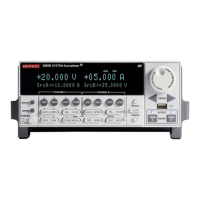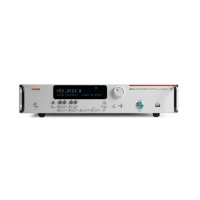7: TSP command reference Series 2600B System SourceMeter® Instrument
7-16 2600BS-901-01 Rev. B / May 2013
Usage
basetime = bufferVar.basetimestamp
The timestamp of the first stored reading
The reading buffer; can be a dynamically allocated buffer (user-defined), or a
dedicated reading buffer (such as
)
Details
This read-only attribute contains the timestamp (in seconds) of the first reading stored in a buffer (rb[1] stored
in reading buffer rb). The timestamp is the number of seconds since 12:00 AM January 1, 1970 (UTC) that the
measurement was performed and stored.
For dedicated reading buffers, all buffer attributes are saved to nonvolatile memory only when the reading buffer
is saved to nonvolatile memory.
See the smuX.nvbufferY attribute for details on accessing dedicated reading buffers.
Example
basetime = smua.nvbuffer1.basetimestamp
print(basetime)
Read the timestamp for the first reading
stored in dedicated reading buffer 1
(source-measure unit (SMU) channel A).
Output:
1.28300e+09
This output indicates that the timestamp is
1,283,000,000 seconds (which is Saturday,
August 28, 2010 at 12:53:20 PM).
Also see
Reading buffers (on page 3-6)
smuX.measure.overlappedY() (on page 7-209)
smuX.measure.Y() (on page 7-213)
smuX.nvbufferY (on page 7-215)
smuX.trigger.measure.Y() (on page 7-244)
bufferVar.cachemode
This attribute enables or disables the reading buffer cache (on or off).
Type TSP-Link accessible Affected by Where saved Default value
Usage
cacheMode = bufferVar.cachemode
bufferVar.cachemode = cacheMode
The reading buffer cache mode; set to one of the following:
• 0: Cache mode disabled (off)
•
: Cache mode enabled (on)
The reading buffer; can be a dynamically allocated user-defined buffer or a
dedicated reading buffer

